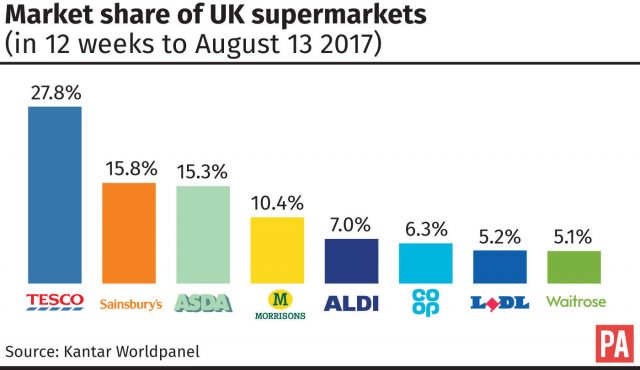Lidl has overtaken Waitrose to become the UK’s seventh largest supermarket as shoppers cope with inflation by turning to the discounters, figures show.
The German retailer increased its market share to a record high of 5.2% over the 12 weeks to August 13, according to Kantar Worldpanel, as 10 million households visited its expanding network of stores. It increased sales by 18.9% overall, with alcohol and fresh produce performing particularly well.
Aldi was not far behind with sales growth of 17.2%, attracting 1.1 million more shoppers than this time last year and increasing market share to 7%. The discounters’ success coincides with like-for-like grocery inflation increasing slightly to 3.3% after holding steady at 3.2% for the past two months.

At the current rate, price increases could add a further £138 to the average household’s annual grocery bill, with the price of butter and fish most affected, Kantar said.
Overall supermarket sales grew by 4% year on year, although the disappointing summer weather saw sales of ice cream down 9% and burgers slumping by 25% – an £8 million loss year on year.
All four of Britain’s biggest grocers managed a growth in sales for the fifth consecutive period, a run of collective success not seen since 2013. However, pressure from the discounters means they now account for just 69.3% of the UK grocery market, down from 76.3% five years ago.
Tesco saw overall sales grow by 3% but its market share fell to 27.8%, while Morrisons increased sales by 2.6% as its market share dropped slightly to 10.4% and Sainsbury’s sales rose by 2% as its share fell to 15.8%.
#Lidl grows sales 40% faster with families, who buy more each time they shop, than with households without children. https://t.co/Ihi4n2zHv0 pic.twitter.com/oZ1UcrSEFN
— Kantar Worldpanel (@K_Worldpanel) August 22, 2017
Asda sales were up 1.4% during the quarter, and Waitrose’s market share held steady at 5.1% as it increased sales by 2.8% year on year, continuing an unbroken run of growth since March 2009, but the Co-op’s sales declined by 0.4% as its market share fell to 6.3%.
Fraser McKevitt, head of retailer and consumer insight at Kantar Worldpanel, said: “Lidl is growing sales 40% faster with families than with households without children.
“Families tend to buy more items each time they shop, so strong growth with this demographic has helped Lidl to increase its average basket size year on year.”
Meanwhile, figures from Nielsen also show the return of cooler weather and the exodus of people on summer holidays combined to bring a halt to two months of impressive sales growth for the UK’s leading supermarkets.
GB Grocery share data from our @K_Worldpanel Download the press release or embed our chart in your website: https://t.co/gCuKPOcErG pic.twitter.com/7d6YbpV6S1
— Kantar (@Kantar) August 22, 2017
Following the highest year-on-year rise for at least four years in how much shoppers spent on groceries – 5.1% last month – sales grew at just 2.5% in the four weeks ending August 12.
Mike Watkins, Nielsen’s UK head of retailer and business insight, said: “It’s a bit of a reality check after two months of really impressive growth, as shopping patterns were disrupted by the return of cooler weather and people going on their summer holidays.
“Although the market has recovered from the low-point 12 months ago, the return of inflation and rising concerns about the economy mean the weekly grocery shop is now the most popular target for people to cut down on household expenses. Thirty per cent of Britons now admit to buying cheaper grocery brands to save money.”






